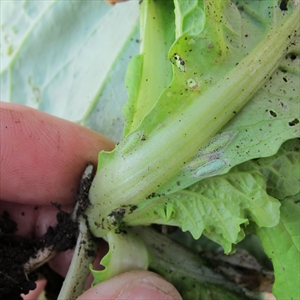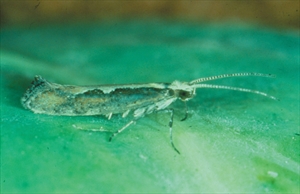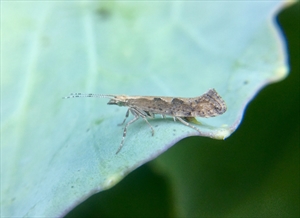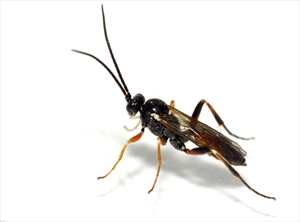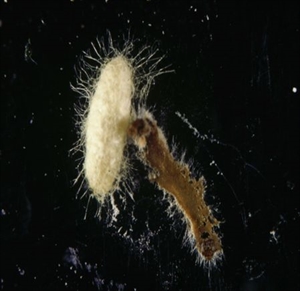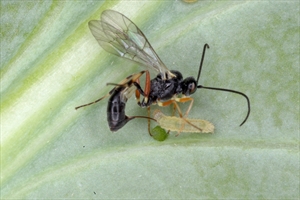Diamondback moth
Pacific Pests, Pathogens and Weeds - Online edition
Pacific Pests, Pathogens & Weeds
Cabbage diamondback moth (020)
Plutella xylostella
Asia, Africa, North, South and Central America, the Caribbean, Europe, Oceania. It is recorded from American Samoa, Australia, Fiji, Guam, New Caledonia, New Zealand, Northern Mariana Islands, Palau, Papua New Guinea, Samoa, Solomon Islands, Tonga, and Vanuatu..
Members of the cabbage (brassica) family, e.g., head cabbage, Chinese cabbage, radish, cauliflower and broccoli; Amaranthus and watercress.
The caterpillars do the damage. The first two stages are small and feed by mining the leaf; later, when they are larger they burrow through the leaf. The result is 1-2 cm wide cavities on the lower leaf surface leaving the waxy layer intact, which gives the appearance of windows in heavily damaged plants (Photo 1). Later, the caterpillars eat through the leaf (Photos 2&3).
The eggs are small (0.4 mm long), cylindrical or oblong, white when laid, changing to yellowish brown as they mature and ready to hatch. The eggs are mostly laid singly or in groups of two or three, on the lower leaf surface along major veins. One adult female lays 100-150 eggs in a life span of 3-7 days. The incubation period ranges from 3-8 days depending on the temperature.
There are four larval or caterpillar stages. At hatching, the caterpillars are grey-green; later, when fully grown, they are dark green and approximately 12 mm long (Photos 1&2). When disturbed, the larvae wriggle backwards, and may drop from the leaf on a silk thread. The larval period ranges from 14-28 days, after which they make a silken cocoon and pupate (Photo 4).
The pupa is dark green or light brown, about 10 mm long, and usually stuck to the underside of the leaf. The pupal stage lasts 5-10 days, depending on temperature.
After pupation, the adult moth emerges from the cocoon. It is about 10 mm long with a 13 mm wingspan, dark brown with three white diamond-shaped patterns on its back; these give the moth its common name (Photos 5&6).
The life cycle is complete in less than 1 month (14 days at 25°C), depending on the temperature. The moth is most active at night.
Economic damage is most severe when heading begins. The caterpillars tunnel into the leaves of the forming heads of cabbages. The diamondback moth is the most destructive insect pest of brassica crops throughout the world. Worldwide, the management of the annual damage caused by this insect has been estimated to be US$4-5 billion!
Note: other pests often occur on ball cabbages along with this moth, and the combined damage is considerable. The other pests are cabbage centre grub, Hellula undalis (see Fact Sheet no. 114); cutworm, and cluster caterpillar, Spodoptera litura; or cabbage cluster caterpillar (large cabbage moth, LCM), Crocidolomia pavonana (see Fact Sheet no. 78).
It is very important to monitor the start of diamondback moth infestations; this can be done by:
- Visiting the field every day, looking for any adults or larvae on the plants.
- Putting yellow sticky traps in the field to catch flying adults.
- Putting sticky traps baited with diamondback moth sex pheromone to trap male adults.
Look for larvae (caterpillars) that are pale green and slightly tapered at each end. They grow through four stages (to a length of about 12mm), and have a dark head in the first two stages. They wriggle when disturbed, often dropping from the plant on a silken thread. Look for the moth with a diamond pattern on the back.
NATURAL ENEMIES
There are several parasitoids of the different stages: eggs - Trichogrammatoidea bactrae; caterpillars - Cotesia vestalis, Diadegma semiclausum, Microplitis plutellae, Oomyzus sokolowskii; pupae - Diadromus collars. Cotesia is found in the tropical lowlands (Photos 7&8), whereas Diadegma (Photos 9&10) is common above 800 m in the cooler highlands.
CULTURAL CONTROL
Before planting:
- Always start with healthy, insect-free seedlings.
- Grow head cabbages during the cooler times of the year (June-November) to avoid infestations.
- Grow collard greens (Brassica oleracea), mustard (Brassica juncea) or Chinese cabbage (Bok Choy) as trap crops. Trap crops for the other species are: (i) radish and green mustard (Brassica juncea) for Hellula undalis; (ii) Chinese cabbage (Brassica pekinensis cv. Tempest) or flowering green mustard for Crocidolomia pavonana. (Note that the latter is also useful as a trap crop for Halticus tibialis). The companion crop is planted between rows of cabbages and other Brassica species. Plant a first row of the companion crop about 15 days before transplanting the cabbages, and a second row about 25 days after transplanting. The idea is to destroy the trap crop before the eggs hatch.
- Where farmers have the resources, grow plants under nets or in screenhouses.
During growth:
- Handpick larvae when numbers are low.
- Destroy crucifer weeds before planting and during the cropping period.
- For watercress grown on rafts in the river (Solomon Islands), sink one half for 30 minutes to drown the caterpillars, and then do the same for the other half. Drowning one half of the plants, then the other half, is done so that spiders are able to survive. Spiders are natural enemies of the diamondback moth caterpillars.
- Monitor the crop regularly, looking for eggs and recently hatched caterpillars.
After harvest:
- Collect and destroy crop debris after harvest.
CHEMICAL CONTROL
If pesticides are used, there is need for careful choice. If one chemical is used all the time, it is likely that the diamondback moth will develop resistance to it. Do the following:
- Use plant-derived products, such as neem, derris, pyrethrum and chilli (with the addition of soap), or commercial products that contain disease-causing organisms, such as spinosad (Success) and Bt - Bacillus thuringiensis var. kurstaki, or var. aizawai.
- If using Bt:
- Apply when the caterpillars are at an early stage of development.
- Spray in the late afternoon or early evening, when the caterpillars are actively feeding and when the effect of UV on Bt will be less.
- Two synthetic products with different modes of action are indoxacarb (Steward) and chlorantraniliprole (Prevathon). They should be used only when necessary (i.e., when there is likely to be economic damage to the crop), each should be applied only once during the pest's lifecycle and they should be alternated to slow the development of resistance.
____________________
When using a pesticide, always wear protective clothing and follow the instructions on the product label, such as dosage, timing of application, and pre-harvest interval. Recommendations will vary with the crop and system of cultivation. Expert advice on the most appropriate pesticides to use should always be sought from local agricultural authorities.
AUTHORS Grahame Jackson & Mike Furlong
Information from CABI (2019) Plutella xylostella (diamondback moth). Crop Protection Compendium; and from Walker K (2007) diamondback moth (Plutella xylostella): PaDIL - http://www.padil.gov.au; and Diamondback moth (2021) AgricultureVictoria, Australia. (https://agriculture.vic.gov.au/biosecurity/pest-insects-and-mites/priority-pest-insects-and-mites/diamondback-moth); and Diamondback moth Plutella xylostella. Cesar Australia and South Australian Research and Development Institute. (https://cesaraustralia.com/pestnotes/caterpillars/diamondback-moth/); and Diamonback moth: cabbage in Indonesia and Western Australia (2020) Agriculture and Food. Department of Primary Industries and Regional Development. Government of Western Australia. (https://www.agric.wa.gov.au/broccoli/diamondback-moth-cabbage-pest-indonesia-and-western-australia); and from Mike Furlong (pers. comm.), University of Queensland, Australia. Photos 1&2 Graham Walker, Plant and Food Research, Auckland, New Zealand. Photo 4 Richard Markham, ACIAR, Canberra. Photo 4 Jack Kelly Clark, US Statewide IPM Project. Photos 5,7-9) Mike Furlong, University of Queensland, Australia. Photo 6 Mani Mua, SPC, Sigatoka Research Station, Fiji.
Produced with support from the Australian Centre for International Agricultural Research under project PC/2010/090: Strengthening integrated crop management research in the Pacific Islands in support of sustainable intensification of high-value crop production, implemented by the University of Queensland and the Secretariat of the Pacific Community.



